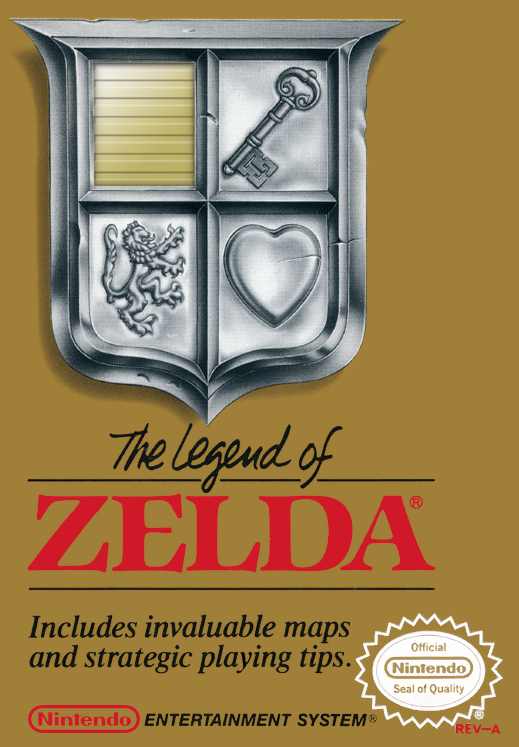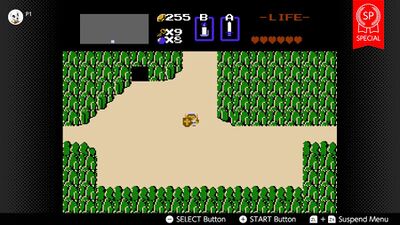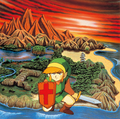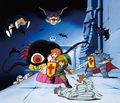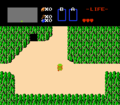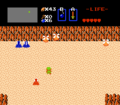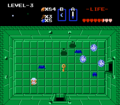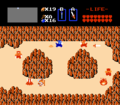The Legend of Zelda
- This page is about the game. For the series, see The Legend of Zelda (Series).
| Release | ||
|---|---|---|
Platform | Date | |
| ||
Switch (Special Edition) | ||
| Credits | ||
Developer | ||
Publisher | ||
Producer | ||
Director | Shigeru Miyamoto | |
| Guides | ||
Walkthrough | ||
| Media | ||
Gallery | ||
Music | ||

|
In-depth guide:
The Legend of Zelda Walkthrough |
The Legend of Zelda (or The Hyrule Fantasy: Legend of Zelda in Japan) is the first game in The Legend of Zelda video game series. Although not the first adventure game, it is often credited for perfecting the adventure genre. The game was first released in 1986 in Japan, and in 1987 everywhere else.
Gameplay
The goal of The Legend of Zelda is to collect the 8 pieces of the Triforce of Wisdom, defeat Ganon, and to rescue Princess Zelda. To obtain the pieces of the Triforce of Wisdom, the player must take on the role of the hero, Link, and explore the first eight dungeons in the game before embarking on the journey to the final dungeon, Level 9: Death Mountain, to defeat the evil wizard Ganon.
Controls
D Pad: Moves Link around and selects his secondary item[1]
A: Sword Attack[2]
B: Secondary Item[3]
Start: Brings up the sub screen[4]
Select: Moves the cursor on the save select screen and pauses[5]
Save Select
The Legend of Zelda was the first NES cartridge in North America to have a battery-backed save feature.[6] On the select screen, the player can continue their progress, register a name, or eliminate a file. When the player registers a file name, they start a new game and create a name for the file. In elimination mode, the player is able to erase one of the files so they are able to start a new game on that file. The numbers below the name of a file represent the number of game overs that occurred while playing on that particular file. The hearts under "Life" represent the amount of remaining health in Link's quest.
Development
- Main article: The Legend of Zelda Staff
The Legend of Zelda and the original Super Mario Bros. were being designed simultaneously by the same development team. They had set out to make the games opposite of one another. Mario would follow a linear pathway, while The Legend of Zelda would have a more open world experience. Shigeru Miyamoto got the idea of the open world experience from his childhood, where he would go out exploring into the wilderness.[7] Miyamoto was less concerned with Zelda being a game of getting the most points or reaching the end of a linear path. Instead, Miyamoto wanted gamers to relax and enjoy themselves as they made their way through the adventure. It was because of this that some basic gameplay elements, such as communicating with characters and shop owners were included.[8]
The name for Princess Zelda was inspired by Zelda Fitzgerald. Miyamoto stated, "Zelda was the name of the wife of the famous novelist Francis Scott Fitzgerald. She was a famous and beautiful woman from all accounts, and I liked the sound of her name. So I took the liberty of using her name for the very first Zelda title."[9]
On February 21, 1986, The Legend of Zelda released as a launch title for the Famicom Disk System; it was released alongside several other titles including a re-release of Super Mario Bros, along with a number of sports titles.
Story
The story of The Legend of Zelda is very simple and follows most fairy tale ideas; Princess gets captured by a giant monster, hero must save princess, hero travels all over the land to save princess, hero defeats monster and saves princess. The only hint to a story and motivation of saving the princess was a short paragraph at the beginning of the game. Here it is, keep in mind that this is the original NES English localization:
"MANY YEARS AGO PRINCE DARKNESS GANNON STOLE ONE OF THE TRIFORCE WITH POWER. PRINCESS ZELDA HAD ONE OF THE TRIFORCE WITH WISDOM. SHE DEVIDED IT INTO 8 UNITS TO HIDE IT FROM GANNON BEFORE SHE WAS CAPTURED. GO FIND THE 8 UNITS LINK TO SAVE HER."
This was later revised to fix all the translation errors, such as GANNON being updated to GANON, and TRIFORCE WITH POWER/WISDOM to TRIFORCE OF POWER/WISDOM. For the whole plot of The Legend of Zelda see the PLOT section below.
Plot
- Main article: The Legend of Zelda Story
- This story is taken directly from the western localization of the game's instruction manual...
A long, long time ago the World was in an age of Chaos. In the middle of this chaos, in a little kingdom in the land of Hyrule, a legend was being handed down from generation to generation, the legend of the "Triforce"; golden triangles possessing mystical powers.
One day, an evil army attacked this peaceful little kingdom and stole the Triforce of Power. This army was led by Ganon, the powerful Prince of Darkness who sought to plunge the World into fear and darkness under his rule. Fearing his wicked rule, Princess Zelda, the princess of this kingdom, split the Triforce of Wisdom into eight fragments and hid them throughout the realm to save the last remaining Triforce from the clutches of the evil Ganon. At the same time, she commanded her most trustworthy nursemaid, Impa, to secretly escape into the land and go find a man with enough courage to destroy the evil Ganon. Upon hearing this, Ganon grew angry, imprisoned the princess, and sent out a party in search of Impa.
Braving forests and mountains, Impa fled for her life from her pursuers. As she reached the very limit of her energy she found herself surrounded by Ganon's evil henchmen. Cornered! What could she do? ... But wait!
All was not lost. A young lad appeared. He skillfully drove off Ganon's henchmen, and saved Impa from a fate worse than death. His name was Link. During his travels he had come across Impa and Ganon's henchmen. Impa told Link the whole story of the princess Zelda and the evil Ganon. Burning with a sense of justice, Link resolved to save Zelda, but Ganon was a powerful opponent. He held the Triforce of Power. And so, in order to fight off Ganon, Link had to bring the scattered eight fragments of the Triforce of Wisdom together to rebuild the mystical Triangle.
If he couldn't do this, there would be no chance Link could fight his way into Death Mountain where Ganon lived. Can Link really destroy Ganon and save the Princess Zelda? Only your skill can answer that question. Good luck. Use the Triforce wisely.
Timeline Placement
The Legend of Zelda features the same Link as its direct sequel, Zelda II: The Adventure of Link. In 1991 when A Link to the Past was released, it was a distant prequel to the first two Zelda titles. Over the next 20 years, the series expanded rapidly with new games and the timeline became a bit more blurry. The Legend of Zelda had a direct timeline placement with The Adventure of Link and A Link to the Past, but very little in relation to the rest of the series.
In December of 2011, The Legend of Zelda: Hyrule Historia revealed the complete Legend of Zelda timeline. It was revealed that there were three outcomes branching from Ocarina of Time. One of the outcomes involved Link failing to defeat Ganondorf and is often referred to as the "Downfall" or "Decline" branch of the timeline. After Ocarina of Time, the Decline Timeline continues with the Imprisoning War, followed by the events of A Link to the Past, Oracle of Seasons and Oracle of Ages, Link's Awakening, The Legend of Zelda and The Adventure of Link.
Reception
The Legend of Zelda was a huge commercial success, having become one of the highest selling titles for the Nintendo Entertainment System. The game sold 6.51 million copies.[10]
The Legend of Zelda was a critical success as well, ranking at the #1 spot in the original NES Top 30 listing of Nintendo Power magazine.[11] Nearly 7 years later, Nintendo Power retired the Top NES list in January of 1995. The Legend of Zelda was given Hall of Fame status, being one of the all-time greatest titles and having been on the charts for a record 76 months.[12]
The Legend of Zelda placed first in Game Informer's "The Top 200 Games of All Time" list.[13]
Legacy
The Legend of Zelda was paramount in establishing the Action-Adventure genre.[14] Several games in the late 80's and 90's replicated the formula with games even today being referred to as being Zelda-like or Zelda-clones. Some games such as 3D Dot Game Heroes have been cited as being almost exact replicas of the Zelda series.[15] All development versions of subsequent 3D Zelda games have used A as the sword button, despite the fact that B is always used as the sword button in release versions.
The original The Legend of Zelda started the Legend of Zelda, a series that has lasted over 25 years and featured over 20 games, including the various side stories and multiplayer games, while selling over 60 million games as of 2011.[16]
Re-Releases
The Legend of Zelda was one of the most highly acclaimed games of all time and this warranted several re-releases. In November of 2003, the game was re-released as part of the The Legend of Zelda: Collector's Edition for the Nintendo GameCube. The Collector's Edition included The Legend of Zelda, The Adventure of Link, Ocarina of Time, and Majora's Mask.
The game's first re-release was on the Nintendo Famicom as a cartridge title in 1994, as the game had first been released for the Famicom Disk System years before.
In 2004, The Legend of Zelda was re-released for the Game Boy Advance as part of the Classic NES Series. Zelda II: The Adventure of Link was also a part of this series, along with other popular NES titles including Super Mario Bros, Donkey Kong, Bomberman, Excitebike, and several others.
In 2006, The Legend of Zelda sought yet another re-release, this time as a Virtual Console title for the Nintendo Wii. Several other Legend of Zelda titles have since been released onto the Virtual Console.
The Nintendo 3DS released in 2011 at the price of $249.99 (US Dollars). After slow sales numbers early on, Nintendo announced a significant price cut to $169.99. In gratitude for purchasing the system earlier at the higher price, early adopters became part of the Ambassador program, getting ten free NES games and ten free GBA games for download. The NES games released on September 1st, 2011, including another release of The Legend of Zelda. Zelda II: The Adventure of Link was also included as part of the Ambassador program. On July 5, 2012, as part of "8-Bit Summer", this digital release of the game was made available to all Nintendo 3DS owners via the Nintendo eShop.
The Legend of Zelda is also found on the Nintendo Wii U Virtual Console. It originally released in Japan on August 28th, 2013,[17] and became available in North America on September 29th, 2013.
With the release of the Nintendo Switch Online Service, a piece of software allows the user to play games originally released for the Nintendo Entertainment System. Included with the first selection of games was The Legend of Zelda, which was simultaneously released on September 19th, 2018 (September 18th in the Americas). In this version, two players are able to play together, where one player controls Link, and the other can view the gameplay. The two players can switch roles at any time.
As a follow up to the release of the original game, on October 10th, 2018 (October 9th in the Americas) a 'Special Edition' was added to the NES online app, on the Switch. This version of the game is aimed towards newer players, as Link starts the game with 6 hearts, 255 Rupees, 9 Keys, 8 Bombs, as well as certain items, including the White Sword, the Magical Shield, the Blue Ring, and more. This version of the game is dubbed The Legend of Zelda - Living the life of luxury! A red banner is omnipresent on the border of the game, denoting that it is the special edition. The description given to the game is as follows:
"In this souped-up version of The Legend of Zelda, you'll start with a ton of rupees and items! You'll begin with all equipment, including the White Sword, the Magical Shield, the Blue Ring, and even the Power Bracelet. But if Ganon's still giving you a hard time, the power of money will overcome! Just buy yourself some more items and give it another shot! Beating the game once grants you access to a more difficult version of the game called Second Quest."
Controversy
Each of the first nine Dungeons in The Legend of Zelda is shaped in a specific design, which corresponds to the name of the dungeon. The first labyrinth is referred to as the Eagle, while the fourth dungeon is referred to as the Snake. The third dungeon of the game is referred to as the Manji, and it is in the shape of a left-facing Swastika. The term Manji is actually a Japanese character and it is very common in Japanese culture. Because of this, it slipped into the game without considering the sensitivity of the symbol. The Manji is considered offensive in western countries due to its relationship to Nazism, though the Nazi swastika faces the opposite direction of the Manji.
All versions of the game include a cross on Link's Shield. However, in virtually all pieces of merchandise, Link's shield is shown in a solid color. This is likely due to the sensitivity of religion in western countries. Furthermore, in the Japanese version of the game, the Book of Magic was referred to as the Bible. When the game was released in the West, it was renamed to the Book of Magic, or the Magic Book.
Characters
Enemies
Bosses
Items
Dungeons
Locations
Merchandise
- The Delta Apparel Link Kneeling Shirt wasn't released at the time of the original The Legend of Zelda, but it contains the original games Logo and Official Artwork.
Gallery
- Main article: Gallery:The Legend of Zelda
- See also: Gallery:The Legend of Zelda Bosses, Gallery:The Legend of Zelda Characters, Gallery:The Legend of Zelda Enemies, Gallery:The Legend of Zelda Items, and The Legend of Zelda Instruction Manual
Screenshots
- Main article: Category:The Legend of Zelda Screenshot Files
A room from Level 3: The Manji
Videos
Legend of Zelda and it's really rad! Commercial
Pe Pe Peahats! Commercial
Game Intro
Zelda Dungeon Video Walkthrough
Zelda Dungeon Glitchless Traditional Dungeon Order speedruns
Zelda Dungeon Second Quest Let's Play
Trivia
- The Japanese version of The Legend of Zelda is known as The Hyrule Fantasy.
- Despite initial runs of The Legend of Zelda being in shiny Gold cartridges, the later Gray re-release versions are more rare. However, compared to most NES titles, both versions are fairly common.
- There is a Second Quest in The Legend of Zelda, which places Dungeons in different spots, as well as all Heart Containers and Secret Moblin locations.
- The maximum amount of Rupees that Link can hold in The Legend of Zelda is 255, due to the fact that the value is held as an 8 bit integer.
External links
- Japanese Official Website (for the release in Game & Watch: The Legend of Zelda)
References
- ↑ "[D Pad:] Moves Link/Selects "B" item", The Legend of Zelda Instruction Booklet, pg. 16
- ↑ "[A:] For attacking with the sword", The Legend of Zelda Instruction Booklet, pg. 16
- ↑ "[B:] For using and attacking with gadgets (treasure etc.)", The Legend of Zelda Instruction Booklet, pg. 16
- ↑ "[Start:] For selecting main/sub screen", The Legend of Zelda Instruction Booklet, pg. 16
- ↑ "[Select:] Pause/restart buttons", The Legend of Zelda Instruction Booklet, pg. 16
- ↑ mobygames.com
- ↑ SuperPlay, April 23rd, 2003
- ↑ NTSC-UK, August 20th, 2003
- ↑ Miyamoto Interview by Todd Mowatt
- ↑ The Legend of Zelda Lifetime Sales
- ↑ Nintendo Power Magazine: Issue #1 July / August 1988
- ↑ Nintendo Power Magazine: Issue #68 January 1995
- ↑ {{{1}}}
- ↑ Azubu: Games That Were Genre Pioneers
- ↑ Just How Zelda-like is 3D Dot Game Heroes?
- ↑ April 2011: Legend of Zelda Series 62 Million Games Sold
- ↑ Wii U Virtual Console Site




